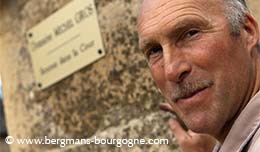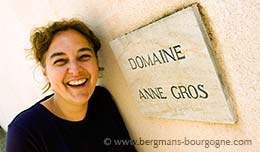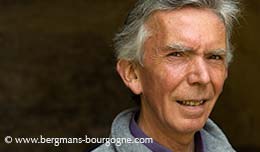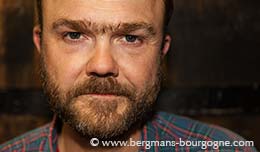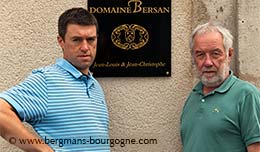
eet the family, the Chambolle family. At Domaine Comte Georges de Vogüé in Chambolle-Musigny the focus is solely on the wines of the village, well-known names such as Les Amoureuses, Bonnes Mares and Musigny.
– Musigny is the boss, the patriarch, explains winemaker François Millet. Les Amoureuses is the wife, she's the first lady of the village. You have the Chambolle-Musigny premier cru, which is the future boss; not ready today, too young. The village level Chambolle-Musigny is the child of the family. Bonnes Mares is different; it's not the same blood. It's an old uncle, by marriage, from Sweden.
 This is a domaine which dates back to the 18th century. Today's team arrived at the domaine between 1986 and 1996 – François Millet in 1986, Eric Bourgogne, responsible for the vineyards, in 1996 and Jean-Luc Pépin, responsible for the commercial side, in 1988.
This is a domaine which dates back to the 18th century. Today's team arrived at the domaine between 1986 and 1996 – François Millet in 1986, Eric Bourgogne, responsible for the vineyards, in 1996 and Jean-Luc Pépin, responsible for the commercial side, in 1988.
– Our vineyards cover 12,5 hectares, says Eric Bourgogne. North of the village are three appellations – the grand cru Bonnes Mares, a small parcel of Chambolle-Musigny premier cru Les Baudes and a small parcel of Chambolle-Musigny premier cru Les Fuées. We have a parcel of village appellation east of the village. South of the village are Les Amoureuses and Musigny.
François Millet uses the family metaphor to describe the characters of the wines and the relationship between them. Musigny and the different Chambolle-Musigny wines are all on the Comblanchien limestone, whereas Bonnes Mares is on Bajocian limestone. The latter type of limestone begins in Bonnes Mares and continues through Clos de Tart and Clos des Lambrays in Morey-Saint-Denis all the way up to Chambertin.
 – It's a different family. Different soil, different subsoil, says François Millet about the Bonnes Mares.
– It's a different family. Different soil, different subsoil, says François Millet about the Bonnes Mares.
Musigny is often described as a feminine wine, a view that François Millet doesn't subscribe to.
– I don't agree with that he says. Because I think that things have to be seen as a whole within the village. If Musigny was a woman, what would Les Amoureuses be? Musigny has a feminine side, but it has the substance of a patriarch. It's not a rustic patriarch. He has elegance. Amoureuses, she's a woman. Very feminine, a beauty.
– Bonnes Mares is a man. As a wine person he is very convivial. Talkative. He needs contact. He has the attitude of a man.
 – I'm using the words man and woman instead of masculine and feminine, because there is something masculine and something feminine in everybody, man or woman. That's why I prefer to use the family metaphor, where everyone has a role to play. Even the Bonnes Mares.
– I'm using the words man and woman instead of masculine and feminine, because there is something masculine and something feminine in everybody, man or woman. That's why I prefer to use the family metaphor, where everyone has a role to play. Even the Bonnes Mares.
With 2,60 hectares of Bonnes Mares Domaine Comte Georges de Vogüé is the largest owner of the appellation. In total it covers 15 hectares and you'll find the majority of the domaine's vines in the southeastern corner.
– We have several parcels, says Eric Bourgogne. The oldest parcel was planted in 1945 and the most recent in 1995. Then there are parcels planted in 1963, 1984, 1985, 1988 and 1992.
 – The soil is not very deep. Depending on the parcel it varies from 15–20 cm to 80 cm. There are a lot of stones of different sizes, from two-three centimetres in diameter to 15 centimetres. The soil of Bonnes Mares is not quite as well-drained as Musigny, where the slope is steeper.
– The soil is not very deep. Depending on the parcel it varies from 15–20 cm to 80 cm. There are a lot of stones of different sizes, from two-three centimetres in diameter to 15 centimetres. The soil of Bonnes Mares is not quite as well-drained as Musigny, where the slope is steeper.
The slightly steeper slope in Musigny means a different angle towards the sun. The morning sun will warm the Musigny soil quicker than the Bonnes Mares soil.
– This is interesting, says Eric Bourgogne. It means there is something besides the soil itself that is different between the two appellations, a difference in how the sun affects the humidity in the soil.
Even though there are differences between Musigny and Bonnes Mares he is reluctant to talk about two separate different micro-climates.
 – It is still Chambolle, he says. Like many villages on the Côte Chambolle is at the end of a valley. The valley is a passage for cool air streams from the plateau above. Rain is often very local. It may rain in Musigny, but not in Bonnes Mares, or the other way around.
– It is still Chambolle, he says. Like many villages on the Côte Chambolle is at the end of a valley. The valley is a passage for cool air streams from the plateau above. Rain is often very local. It may rain in Musigny, but not in Bonnes Mares, or the other way around.
– Bonnes Mares always has a more purple hue, says François Millet. Les Amoureuses is ruby. The attitude of Bonnes Mares is different. It is wild. Even though you have the element of red fruits – the cherries, the black cherries – you also have the black fruits – the blueberries. Here the fruits are much more "wild". Blueberries are funny, because they can be very sweet, but also very tannic. You have this astringency and it's very pleasant, and that's what you have in this wine. The energy of this wine is structure, not minerality which is the case for Les Amoureuses. Bonnes Mares is not mineral at all.
– Bonnes Mares is a very independent person. Not conventional. He is free-thinking.
 15 years ago Domaine Comte Georges de Vogüé began reducing the amount of chemicals used in the vineyards. Five years later they stopped using herbicides. Weed-control is done by ploughing. Mildew is controlled with copper and oidium with sulphur.
15 years ago Domaine Comte Georges de Vogüé began reducing the amount of chemicals used in the vineyards. Five years later they stopped using herbicides. Weed-control is done by ploughing. Mildew is controlled with copper and oidium with sulphur.
– The soil became more well-drained when we stopped using herbicides, says Eric Bourgogne. Heavy rain no longer means that we have to pick up the top soil down on the road and have it brought back in to the vineyards.
– We do not use any fertilisers either, because the soil should be self-sufficient. My job is not only about ensuring a ripe harvest. It's to ensure a ripe and healthy harvest. The vines must be healthy. It's a plant that, theoretically, will live for about 50 years.
With 7,20 hectares of Musigny land Domaine Comte Georges de Vogüé is by far the largest owner of this grand cru. The total surface area of the appellation is 10,86 hectares. Except for in the two extremities, the very north of the appellation and the very south, the domaine owns vines all across Musigny.
 – Across Musigny there are small variations in the soil, explains Eric Bourgogne, so each parcel has its own identity; from the stonier, slightly heavy, brown soil at the bottom of the slope to the lighter, somewhat whiter soil found mainly at the top.
– Across Musigny there are small variations in the soil, explains Eric Bourgogne, so each parcel has its own identity; from the stonier, slightly heavy, brown soil at the bottom of the slope to the lighter, somewhat whiter soil found mainly at the top.
All parcels, except for vines 25 years and younger, are blended into one cuvée, the Musigny Vieilles Vignes. This means, as Eric Bourgogne points out, that the Musigny from Domaine Comte Georges de Vogüé will be different, but not necessarily of higher or lesser quality, from the Musignys made by the other owners, who only have single parcels. The wine from ten to 25-year old vines is declassified and bottled as Chambolle-Musigny premier cru. The domaine has some vines in the two Chambolle-Musigny premier crus Les Baudes and Les Fuèes, both located north of the village, close to Bonnes Mares.
– The Chambolle-Musigny premier cru is made exclusively from Musigny young vines, nothing else, says François Millet.
 – In a way, the Chambolle-Musigny premier cru is like tasting Musigny as a young man. A young man speaks more, most of the time that is. It depends on what time it is, but in general I think it's true. It gives you a better understanding of the old vines. If you meet someone for the first time as an adult you don't have the background. Whereas if you have met this person in the past you have much more information, especially if you have met the person as a teenager.
– In a way, the Chambolle-Musigny premier cru is like tasting Musigny as a young man. A young man speaks more, most of the time that is. It depends on what time it is, but in general I think it's true. It gives you a better understanding of the old vines. If you meet someone for the first time as an adult you don't have the background. Whereas if you have met this person in the past you have much more information, especially if you have met the person as a teenager.
He describes Musigny and Les Amoureuses as the most difficult members of the family. Neither of them is forgiving. They will not tolerate any mistakes by the winemaker.
– If you start to provoke these wines, very soon you will receive a bad answer, says François Millet. The wine will be angry. It will not agree with you. The answer will be harsh and tannic. With Bonnes Mares you have a sort of margin for error, up to a certain limit that is.
 Out of the 7,20 hectares of Musigny 0,65 are planted with chardonnay. Normally this will produce grand cru wine, white Musigny, but for the moment the wine is declassified to Bourgogne blanc.
Out of the 7,20 hectares of Musigny 0,65 are planted with chardonnay. Normally this will produce grand cru wine, white Musigny, but for the moment the wine is declassified to Bourgogne blanc.
– When I arrived at the domaine we decided to pull up half of the chardonnay vines, explains François Millet. They were planted in the 1940's and were slowly beginning to die. In 1993 we pulled up the other half of the parcel, so from the 1994 vintage it was all young vines and because of that we decided not to continue bottling it as a grand cru. Legally we could have done it, but not ethically. The transition between 1993 and 1994 was too much of a contrast.
Declassifying the wine from grand cru to the regional appellation at the bottom of the hierarchy may seem drastic, but since neither Chambolle-Musigny premier cru nor Chambolle-Musigny allow chardonnay there is no choice. But when dealing with the French authorities the wine is still declared as a grand cru.
 – Who knows, says François Millet, if Musigny blanc is not declared for some time the INAO might not allow it in the future. We don't know when it will be labelled as grand cru again. I don't know the history of the wine. When I first came here the vines were old. Then they were very young. I don't know if we have to wait 25 years. If it is necessary we will.
– Who knows, says François Millet, if Musigny blanc is not declared for some time the INAO might not allow it in the future. We don't know when it will be labelled as grand cru again. I don't know the history of the wine. When I first came here the vines were old. Then they were very young. I don't know if we have to wait 25 years. If it is necessary we will.
– The wine ages very well. It's a long term wine. I bottle it with the reds, sometimes even after. I always check what's best for the wine of course, it's not something I do out of habit. It means there is strength in this wine. And there is a lot of elegance too. It needs time, it is a slow-ageing wine.
François Millet describes the winemaking at Domaine Comte Georges de Vogüé as very hands-off. Since his arrival not much has changed.
– The more experience you gain, the more you realise how little you have, he says.
– What I always have wanted to do is to translate the beauty of nature. With Eric in the vineyards, that's what we are trying to do. Either you have the attitude that you are stronger than nature and that you have to dominate. You can choose to dominate, but you will quickly realise that these wines hate being forced. So I have always tried to translate the beauty of nature through the vintage. The vintage is the mood of the terroir. The terroir is the person.
© 2012 Ola Bergman










